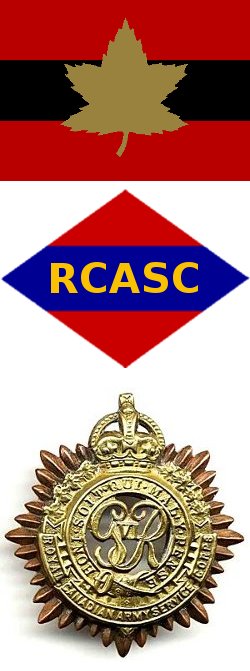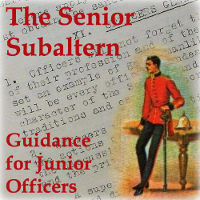Brig. G.E.R. Smith C.B.E.
DDST
Supply and Transport Branch
Adm HQ, First Canadian Army
Completed Staff Work

Top: Tactical sign for the 1st Canadian Army.
Middle: Shoulder flash for RCASC personnel of the 1st Canadian Army.
Bottom: Cap badge of the Royal Canadian Army Service Corps.
1. The doctrine of "completed staff work" will be the doctrine of all HQ. Staffs First Cdn Army S.T.
2. "Completed staff work" is the study of a problem, and presentation of a solution, by a staff officer, in such form that all that remains to be done on the part of the head of the staff division, or the commander, is to indicate his approval or disapproval of the completed action. The words "completed action" are emphasized because the more difficult the problem is the more the tendency to present the problem to the chief in piece-meal fashion. It is your duty as a staff officer to work out the details. You should not consult your chief in the determination of those details, no matter how perplexing they may be. You may and should consult the other staff officers. The product, whether it involves the pronouncement of a new policy or affects an established one, should when presented to the chief for approval or disapproval, be worked out in finished form.
3. The impulse which often comes to the inexperienced staff officer to ask the chief what to do, recurs more often when the problem is difficult. It is accompanied by a feeling of mental frustration. It is so easy to ask the chief what to do, and it appears so easy if you do not know your job. It is your job to advise your chief what he ought to do, not to ask him what you should do. He needs answers, not questions. Your job is to study, write, restudy and rewrite until you have evolved a single proposed action—the best one of all you have considered. Your chief merely approves or disapproves.
4. Do not worry your chief with long explanations and memoranda. Writing a memorandum to your chief does not constitute completed staff work, but writing a memorandum for your chief to send to someone else does. Your views should be placed before him in finished form so that he can make them his views simply by signing his name. In most instances, completed staff work results in a single document prepared for the signature of the chief, without accompanying comment. If the proper result is reached, the chief will usually recognize it at once. If he wants comment or explanation, he will ask for it.
5. The theory of completed staff work does not preclude a "rough draft," but the rough draft must not be a half-baked idea. It must be completed in every respect except that it lacks the requisite number of copies and need not be neat. But a rough draft must not be used as an excuse for shifting to the chief the burden of formulating the action.
6. The "completed staff work" theory may result in more work for the staff officer, but it results in more freedom for the chief. This is as it should be. Further, it accomplishes two things:
(a) The chief is protected from half-baked ideas, voluminous memoranda, and immature oral presentations.
(b) The staff officer who had a real idea to sell is enabled more readily to find a market.
7. When you have finished your "completed staff work" the final test is that:
If you were the chief would you be willing to sign the paper you have prepared, and stake your professional reputation on it being right?
If the answer is in the negative, take it back and work it over because it is not yet "completed staff work."
DDST
HQ First Cdn Army
9 Aug 1943
Signed (G.E.R. Smith) Brigadier
DDST HQ First Cdn Army
- The O'Leary Collection; Medals of The Royal Canadian Regiment.
- Researching Canadian Soldiers of the First World War
- Researching The Royal Canadian Regiment
- The RCR in the First World War
- Badges of The RCR
- The Senior Subaltern
- The Minute Book (blog)
- Rogue Papers
- Tactical Primers
- The Regimental Library
- Battle Honours
- Perpetuation of the CEF
- A Miscellany
- Quotes
- The Frontenac Times
- Site Map
QUICK LINKS

- The Senior Subaltern
- Staff Duties and the Young Officer
- How to Write Effective English
- Notes and Quotes - Staff Duties
- Advice to Officers (1782)
- Mess Rules of the Infantry School (1884)
- A Dozen Military Epigrams (1901)
- How The Loafer's Bred (1904)
- The Promotion and Examination of Army Officers (1904)
- A Few Tips for Officers, Before and After Joining (1906)
- Standing Orders of The RCR (1910)
- Standing Rules for Officers' Messes of The RCR (1913)
- The Young Officer's Guide to Knowledge (1915)
- The Duties of an Officer (1916)
- An Open Letter to the Very Young Officer (1917)
- Advice to a Young Officer (1917)
- Battalion Duties; Officers, NCOs, and Soldiers (1917)
- Pleasing Infantry Brigadiers (1917)
- Role and the Responsibilities of the CO in a Battalion Mess (1917)
- The RCR, "A" Company Standing Orders (1918)
- Some Staff Duties (1923)
- An Officer's Code (1925)
- Hints on Promotion Exams (1925)
- On Writing Appreciations (1926)
- The RCR; Rules for Officers' Messes (1927)
- Morale And Leadership (1929)
- RCSI Hints for Young Officers (1931)
- RCSI Notes on Drill (1931)
- The Study of War by Junior Officers (1932)
- Self-Training (1934)
- "The Problem of the First Ten Years" (1934)
- Standing Orders of The RCR; 1935)
- Customs of the Service (1939)
- Drill and Discipline (1939)
- Leaders Win Where Commanders Lose (1939)
- The Officer and Fighting Efficiency (1940)
- Officers' Mess (RCAF, 1940)
- The Duties of an Officer (1942)
- Comrades in Arms (1942)
- Example Standing Orders - Subalterns (1942)
- Hints for Newly Commissioned Officers (1943)
- Completed Staff Work (1943)
- FOLLOW-ship (1943)
- Hints for Junior Officers (1945)
- Officer-Like Qualities (1948)
- Military Writing (1948)
- An Analysis of the Sub-Unit Commander (1949)
- Leadership (1950)
- Neptune's Notes (undated, 1950s-60s)
- Thinking and Writing (1953)
- Examination Tactics (1953)
- Officers (1954)
- On Writing Examinations (1954)
- Customs of the Army (1956)
- 1st Bn, The RCR, Senior Subaltern (1956)
- Pigs Have Wings (1960)
- Leadership and Man Management (1960)
- Officers (1964)
- 1RCR - The Sergeants' Mess - "Tips" (1971)
- 2RCR Junior Officer's Handbook (1973)
- How to be a Successful Subaltern (1978)
- Foreword to the Infantry Journal, No. 8 (1979)
- Do You Appreciate the Finer Points of Life? (1980)
- The RCR Regimental Standing Orders - Senior Subaltern (1992)
- Infantry Company Command (2016)
- A Miscellany of Advice for Subalterns
- The Young Officer and the NCO - Quotes